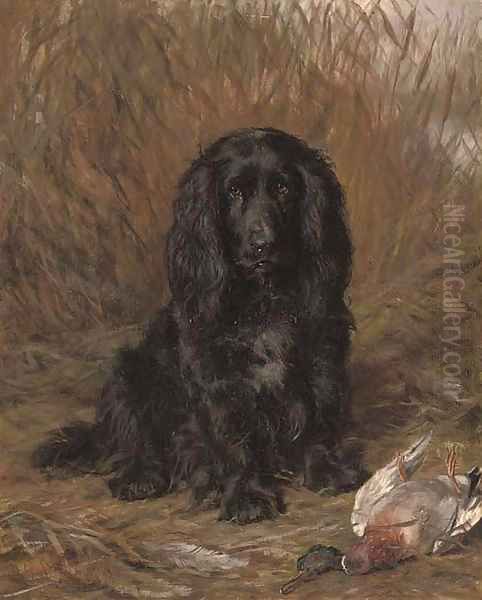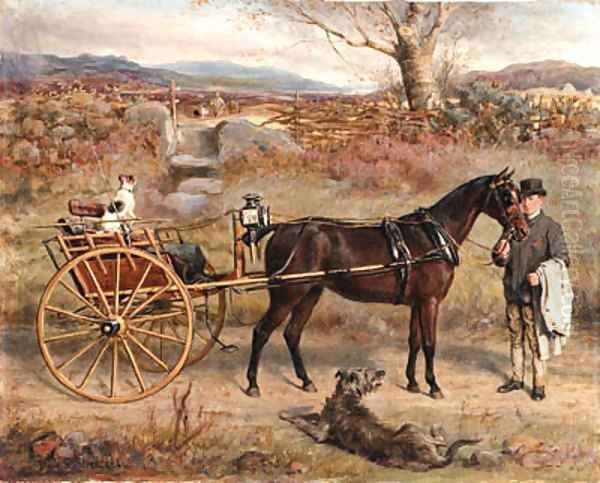David George Steell (1856-1930) was a British artist who carved a niche for himself primarily as a painter of animals, a genre that enjoyed immense popularity throughout the Victorian era. Working in oils, he captured the character and likeness of domestic animals, particularly dogs, with a sensitivity and skill that found favour with patrons and the public. While perhaps not reaching the towering fame of some of his contemporaries, his work remains a charming and valuable contribution to the tradition of British animal painting. His life and career are best understood within the context of his artistically prodigious family and the broader trends in 19th and early 20th-century art.
An Artistic Heritage: The Steell Family
Born in 1856, David George Steell entered a family already distinguished in the Scottish art world. His father was the eminent sculptor Sir John Steell (1804-1891), one of Scotland's most celebrated artists of the 19th century. Sir John was appointed Sculptor to Her Majesty for Scotland and was responsible for numerous iconic public monuments, including the colossal bronze statue of Prince Albert atop the Scottish National Memorial in Edinburgh and the seated figure of Sir Walter Scott within the Scott Monument. His statues of Robert Burns, particularly the one in Central Park, New York, which depicts the poet seated on a tree stump, quill in hand, gazing upwards for inspiration, are renowned for their thoughtful composition and execution. This paternal influence, steeped in classical training and public acclaim, undoubtedly shaped the artistic environment in which David George grew up.

Furthermore, David George's older brother, Gourlay Steell (1819-1894) – note the significant age difference, suggesting they might have been half-brothers or there's a generational skip in common parlance – was also a highly respected animal painter. Gourlay Steell, RSA (Royal Scottish Academy), even succeeded the great Sir Edwin Landseer as Queen Victoria's Animal Painter for Scotland. This direct familial connection to animal artistry at the highest level would have provided David George with both inspiration and, potentially, early tutelage or at least a profound understanding of the genre from a young age. Growing up surrounded by such artistic activity, with a father shaping national monuments and a brother capturing the Queen's beloved pets, must have been a formative experience.
Artistic Development and Focus
While specific details of David George Steell's formal training are not extensively documented in readily available sources, it is highly probable that he received instruction within the family circle and likely attended classes at the Royal Scottish Academy schools in Edinburgh, a common path for aspiring Scottish artists. His chosen specialization in animal painting, particularly dogs and horses, placed him firmly within a popular and commercially viable tradition.
The Victorian era saw an unprecedented rise in pet ownership, especially among the burgeoning middle classes. Dogs, in particular, became symbols of loyalty, companionship, and domestic virtue. This cultural shift fueled a demand for animal portraiture, ranging from grand depictions of prized livestock and sporting animals to more intimate portrayals of household pets. Steell's work catered to this sentiment, capturing not just the physical attributes of the animals but also hinting at their individual personalities and their relationships with humans.
His style can be characterized as Victorian realism, with a keen eye for anatomical accuracy and textural detail – the softness of fur, the gleam in an eye, the alert posture of a terrier. Unlike some of his contemporaries who might have veered more towards the overtly sentimental or the dramatically narrative, Steell's paintings often possess a quieter, more observed quality.
Representative Works and Thematic Concerns
Among David George Steell's known works, "A well-behaved spaniel" (1888) stands out as a quintessential example of his output. This oil painting, measuring 22 x 18 inches (55.9 x 45.7 cm), depicts its subject with a gentle dignity. The title itself suggests the Victorian appreciation for well-trained and companionable animals. The work was sold at Christie's in London, indicating its appeal to collectors of traditional British art. The careful rendering of the spaniel's coat and its patient expression are hallmarks of Steell's approach.

Another notable piece is "Waiting for master," an oil on canvas measuring 25.5 x 31 inches (64.8 x 78.8 cm). This title immediately evokes a narrative, a common trope in Victorian animal painting, designed to elicit an emotional response from the viewer. It speaks to the themes of loyalty and the deep bond between humans and their canine companions. The anticipation and devotion implied in such a scene resonated strongly with Victorian sensibilities. While the specific visual details of this painting are not provided in the initial information, one can imagine a faithful dog, perhaps by a doorway or looking out a window, embodying patience and affection.
His oeuvre likely included various breeds, from sporting dogs like terriers and hounds, reflecting the British passion for country pursuits, to beloved lapdogs. Each painting would have aimed to satisfy the owner's affection for their animal, providing a lasting memento.
The Context of Victorian Animal Painting
David George Steell worked during a golden age for animal painting in Britain. The towering figure in this field was Sir Edwin Landseer (1802-1873), whose dramatic and often anthropomorphic depictions of animals, such as "The Monarch of the Glen" or "Dignity and Impudence," captivated Queen Victoria and the public alike. Landseer's influence was pervasive, setting a high bar for anatomical accuracy, emotional expression, and narrative content. While Steell's work might be seen as less grandiose than Landseer's, it shared the same fundamental respect and affection for animal subjects.
Other prominent animal painters of the era, or those whose careers overlapped or influenced the period, include:
1. Richard Ansdell (1815-1885): Known for his depictions of animals in Scottish landscapes and sporting scenes, often collaborating with figure painters.
2. Briton Rivière (1840-1920): Famous for his paintings of wild and domestic animals, often with classical or biblical themes, imbued with pathos.
3. John Emms (1843-1912): Highly regarded for his spirited and lifelike portraits of hounds and terriers, particularly foxhounds, capturing their energy and character.
4. Maud Earl (1864-1943): A leading female dog painter who achieved international fame for her portraits of various breeds, known for her ability to capture individual canine personalities.
5. George Earl (active 1856-1883): Father of Maud Earl, also a noted sporting and dog painter. His work "The Field Trial" is a significant example of the genre.
6. John Frederick Herring Sr. (1795-1865): Celebrated for his paintings of racehorses, farmyard scenes, and coaching scenes. His sons, John Frederick Herring Jr., Charles Herring, and Benjamin Herring Jr., continued the family tradition.
7. Abraham Cooper (1787-1868): Known for his battle scenes and portraits of horses and dogs, he was a Royal Academician.
8. James Ward (1769-1859): A versatile artist who painted powerful animal subjects, landscapes, and portraits, influenced by the Romantic movement. His "Gordale Scar" is an epic landscape with cattle.
9. Sawrey Gilpin (1733-1807): An earlier artist but foundational for the British tradition of horse painting, known for his elegant and anatomically precise depictions.
10. George Stubbs (1724-1806): Perhaps the most revered British animal painter, whose scientific study of equine anatomy set a new standard for realism and understanding in animal art. His "Whistlejacket" is an icon.
11. Thomas Sidney Cooper (1803-1902): Famous for his pastoral landscapes with cattle and sheep, enjoying a remarkably long and successful career.
12. Heywood Hardy (1842-1933): Painted animals, particularly in 18th-century settings, sporting scenes, and genre subjects with a lively touch.
13. John Sargent Noble (1848-1896): Known for his depictions of animals, especially deer and dogs, often in Highland settings, similar in spirit to Landseer and Ansdell.
These artists, and many others, contributed to a rich tapestry of animal art in Britain. David George Steell's contribution fits within this tradition, focusing on the faithful and affectionate portrayal of animals, a subject matter that continued to find an appreciative audience. His work would have been exhibited alongside such contemporaries, contributing to the diverse offering of the Royal Scottish Academy and other galleries.
Exhibitions and Later Career
It is highly probable that David George Steell regularly exhibited his works at the Royal Scottish Academy in Edinburgh, following the precedent set by his father and brother. He may also have shown his paintings at other institutions in London and provincial cities, as was common for professional artists seeking to build their reputation and secure commissions. The art market of the late 19th and early 20th centuries was robust, with numerous annual exhibitions providing platforms for artists to display and sell their work.
The period from the late Victorian era into the Edwardian period saw continued interest in traditional forms of painting, even as new movements like Impressionism and Post-Impressionism were gaining traction. For an artist like Steell, specializing in a well-loved genre, there would have been a consistent, if perhaps not always headline-grabbing, demand for his skills. He continued to paint into the early 20th century, passing away in 1930. By this time, the art world was undergoing radical transformations, with Modernism challenging many of the conventions that had defined Victorian art.
Legacy and Appreciation
David George Steell's legacy is that of a competent and dedicated animal painter who contributed to a beloved British artistic tradition. While he may not have achieved the same level of fame as his father, Sir John Steell, in the realm of sculpture, or his brother Gourlay Steell in royal animal portraiture, his works possess a quiet charm and technical proficiency that continue to appeal. His paintings offer a glimpse into the Victorian and Edwardian affection for animals, capturing the individual character of his subjects with sensitivity.
The sale of "A well-behaved spaniel" at a prestigious auction house like Christie's in the 21st century demonstrates that there remains a market and appreciation for his work among collectors of British traditional art and animal paintings. His paintings serve as more than just depictions of animals; they are cultural artifacts that reflect the tastes, values, and sentiments of the society in which he lived and worked.
In the broader narrative of art history, artists like David George Steell play an important role. They represent the consistent practice of established genres, maintaining high standards of craftsmanship and catering to the enduring human desire to see beloved aspects of life, such as companion animals, reflected in art. His connection to the esteemed Steell family places him within a significant lineage of Scottish artistic talent, and his own contributions, particularly in the specialized field of animal painting, merit recognition. His works are a testament to a lifelong dedication to capturing the spirit and form of the animal kingdom, a pursuit that brought joy to many patrons and continues to be appreciated by those who encounter his art today. The specific details of his life may be less documented than those of more famous figures, but his paintings speak for themselves, offering a gentle and skilled portrayal of the animals that shared the lives of the people of his time.